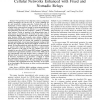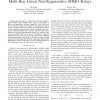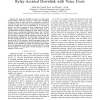ICASSP
2009
IEEE
14 years 3 months ago
2009
IEEE
We introduce a new channel, which consists of an interference channel (IC) in parallel with an interference relay channel (IRC), to analyze the interaction between two selfish and...
GLOBECOM
2009
IEEE
14 years 3 months ago
2009
IEEE
Adoption of relay stations has been commonly accepted as a key technique for future IMTadvanced 4G systems to improve the link performance. While study in relay systems is often c...
WCNC
2010
IEEE
14 years 3 months ago
2010
IEEE
—We study the problem of optimizing the symbol error probability (SEP) performance of cluster-based cooperative wireless sensor networks (WSNs). It is shown in the literature tha...
WCNC
2010
IEEE
14 years 3 months ago
2010
IEEE
—The provision of very high data rates in a ubiquitous manner throughout the service area is a great challenge for 4G and beyond-4G wireless networks. Towards that end, the deplo...
WCNC
2010
IEEE
14 years 3 months ago
2010
IEEE
Abstract—In cognitive mobile multihop relay (CMMR) network, the mobile user as the primary user is allocated with the channel for transmitting data. Relay station as the secondar...
WCNC
2010
IEEE
14 years 3 months ago
2010
IEEE
Abstract—In this paper, a multicarrier multi-hop multipleinput multiple-output (MIMO) relay system is investigated. A linear non-regenerative strategy is applied at each relay no...
IWCMC
2006
ACM
14 years 5 months ago
2006
ACM
Receiver-side relay election has been recently proposed as an alternative to transmitter-side relay selection in wireless ad hoc networks. In this paper we study different priori...
INFOCOM
2006
IEEE
14 years 5 months ago
2006
IEEE
— We consider a mobile ad hoc network consisting of three types of nodes: source, destination, and relay nodes. All the nodes are moving over a bounded region with possibly diffe...
ICWMC
2006
IEEE
14 years 5 months ago
2006
IEEE
— The use of cellular systems enhanced by fixed relays has previously been proposed as a way to provide wide area coverage for high bit-rate at a reduced cost of the wireless ac...
GLOBECOM
2006
IEEE
14 years 6 months ago
2006
IEEE
— We study the downlink coverage of a base station terminal (BST), which has access to a relay node. Continuing a previous study in which the BST is assumed to provide a variable...






